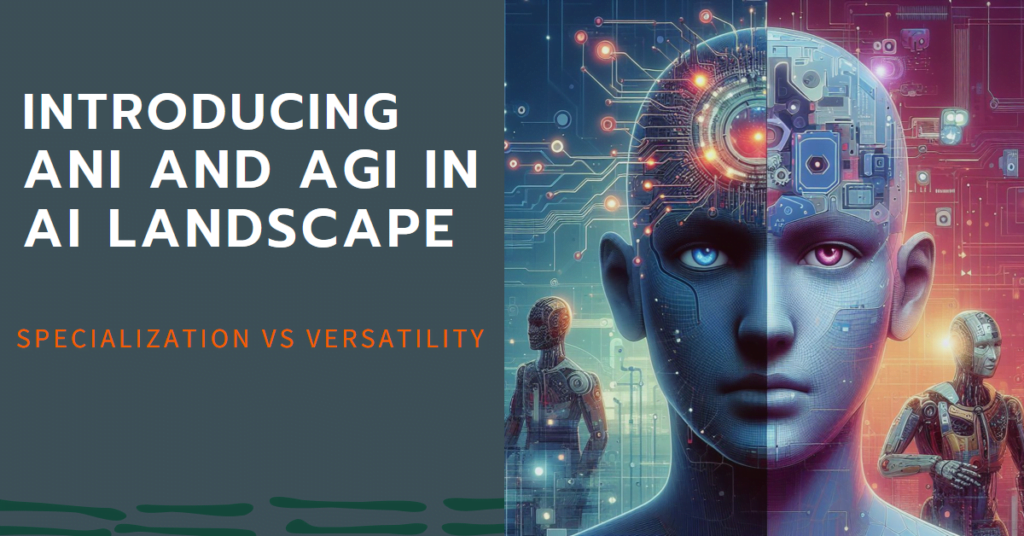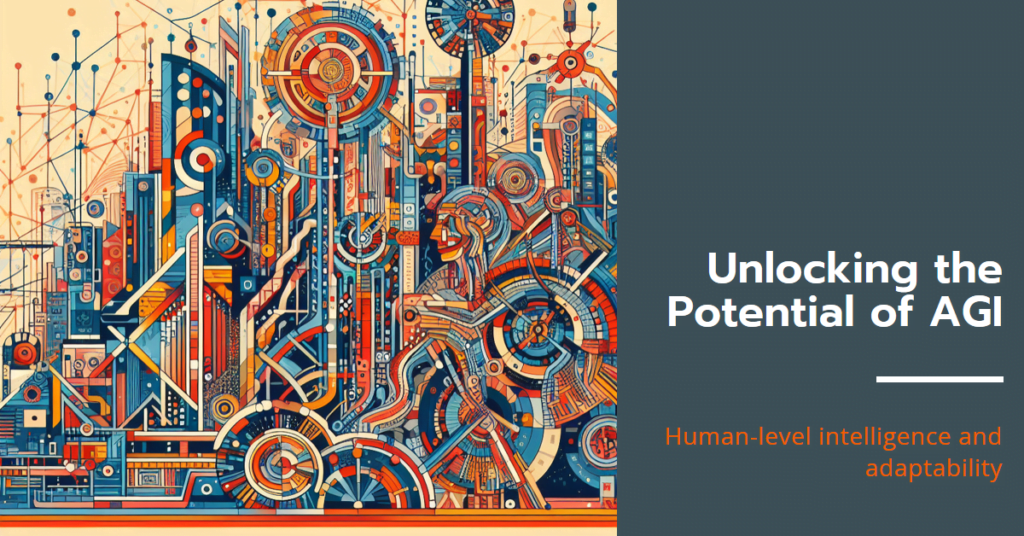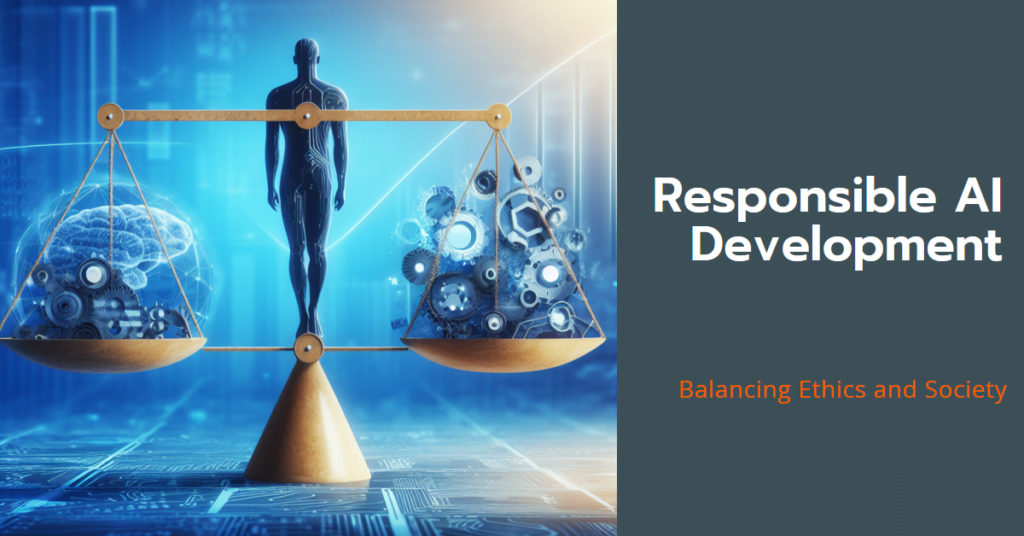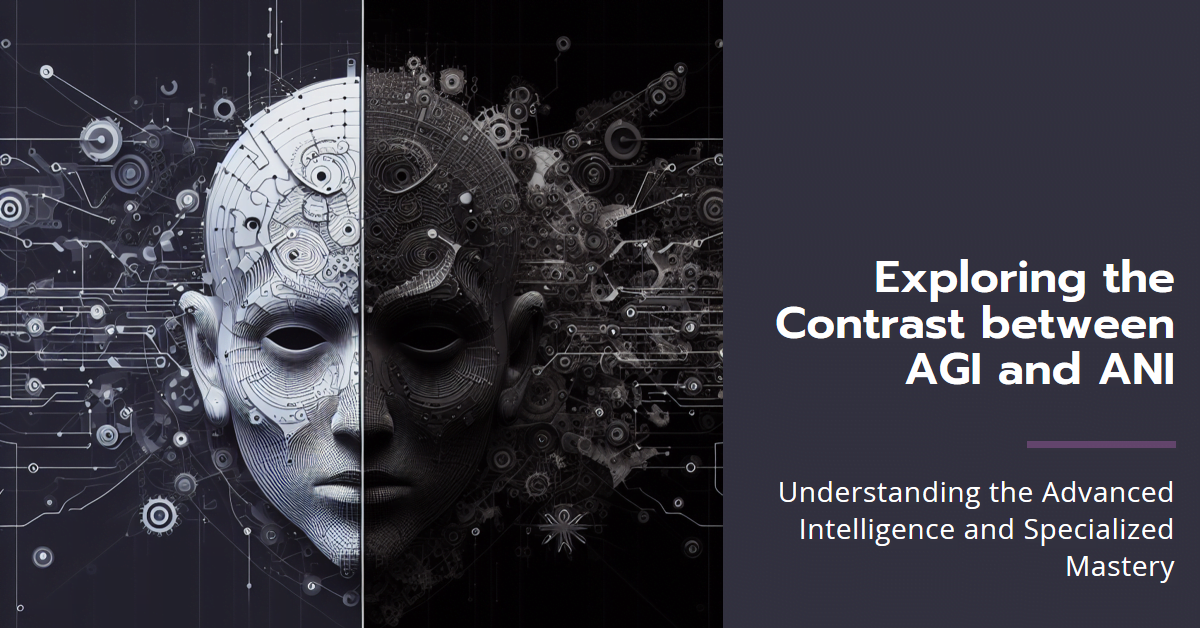As technology continues to evolve, the realm of Artificial Intelligence (AI) is witnessing a significant shift. Two prominent terms in this landscape are Artificial Narrow Intelligence (ANI) and Artificial General Intelligence (AGI). In this blog, we will delve into the distinctions between these two types of AI, their implications for various industries, and the challenges they pose.
Introducing the Players: ANI and AGI

ANI: The Specialized Masters of Today Think of ANIs (Artificial Narrow Intelligence) as masterminds in specific domains. They excel at performing one task exceptionally well, often surpassing human capabilities. From the chess-playing champion Deep Blue to the flawless recommendations provided by your favorite streaming service, ANIs are the driving force behind many technological advancements.
AGI: The Elusive Dream of Tomorrow Artificial General Intelligence (AGI) represents the holy grail of AI research – machines with human-level intelligence, capable of learning, adapting, and understanding the world in its entirety. Imagine a robot that can not only play chess but also compose a winning symphony, write a captivating novel, and hold a philosophical conversation. That’s the promise of AGI.
1. What is Artificial Narrow Intelligence (ANI)?

Understanding ANI:
Artificial Narrow Intelligence (ANI), also known as Weak AI, refers to artificial intelligence systems that are designed and trained for a specific task or a narrow set of tasks. These systems excel in performing well-defined and specific operations, but they lack the general cognitive abilities that a human possesses. ANI is limited to the particular domain or application it was created for and cannot easily adapt to tasks outside its predefined scope.
Examples of Artificial Narrow Intelligence include voice assistants like Siri or Alexa, image recognition systems, language translation tools, and various specialized software used in industries such as finance, healthcare, or manufacturing.
Applications of ANI:
Narrow AI has a wide range of applications across various industries. Some of the most common applications include:
- Virtual Assistants: AI-powered virtual assistants like Siri, Alexa, and Google Assistant can perform tasks such as setting reminders, playing music, or providing weather updates.
- Recommendation Systems: Streaming services like Netflix and Spotify use Narrow AI to analyze user preferences and provide personalized content recommendations.
- Autonomous Vehicles: Self-driving cars use AI to interpret sensory data and make real-time decisions on the road.
- Healthcare: AI algorithms assist in diagnosing diseases, analyzing medical images, and predicting patient outcomes.
- Finance: AI is used for algorithmic trading, fraud detection, and customer service automation in the banking sector.
- Manufacturing: AI optimizes production processes, improves supply chain management, and enhances quality control.
These applications demonstrate the utility of Narrow AI in automating tasks, enhancing efficiency, and providing insights that might not be readily apparent to human analysts.
Limitations:
Artificial Narrow Intelligence (ANI) has several limitations, including:
- Limited Scope: ANI systems are designed to excel in specific tasks but lack the ability to adapt to new situations. They operate within predefined boundaries and may struggle when faced with tasks outside their narrow domain.
- Lack of Human Intelligence: ANI lacks human-like intelligence, empathy, and common-sense reasoning competencies. This limitation restricts its ability to understand context, make nuanced decisions, or fully comprehend complex scenarios.
- Data Dependence: ANI systems heavily rely on the quality and quantity of data provided to them. They may struggle when the data is insufficient or of poor quality, which can impact their performance and reliability.
- Reduced Human Involvement: While ANI can relieve humans from mundane tasks, its reliance on humans to define and prioritize tasks can lead to challenges if the tasks are incorrectly defined or prioritized.
Meta AI Chief on AGI
Yann LeCun Interview2. What is Artificial General Intelligence (AGI)?

Defining AGI:
Artificial General Intelligence (AGI) is a concept in the field of artificial intelligence and machine learning that aims to replicate human intelligence and perform any intellectual task that a human being can. AGI systems are designed to process information at an unprecedented scale, opening up new possibilities for addressing societal challenges, optimizing resource allocation, and finding innovative solutions to problems.
Potential of AGI:
Real-life applications of Artificial General Intelligence (AGI) are still in development, but there are several areas where AGI could potentially have a significant impact. Some potential real-life AGI applications include:
- Healthcare: AGI could assist doctors in diagnosing complex diseases, developing personalized treatment plans, and analyzing vast medical data.
- Transportation and Logistics: AGI could optimize routes, reduce congestion, and enhance safety in transportation and logistics.
- Finance and Banking: AGI could analyze vast financial data, predict market trends, and provide personalized financial advice.
- Education: AGI could offer fun, cheap, and personalized education, democratizing access to high-quality education.
- Elder Care: AGI could take care of the elderly, providing assistance with daily tasks and improving their quality of life.
The Hypothetical AGI: Q-Star (Q) is a research project at OpenAI that aims to develop Artificial General Intelligence (AGI). Q-Star is considered a significant step towards AGI because it has shown impressive logic and long-term strategizing capabilities similar to humans. Although still in its early stages of development, Q-Star has already demonstrated promising results. In one experiment, Q-Star was able to learn to solve a complex mathematical problem without being explicitly programmed to do so. This achievement suggests that Q-Star may be able to learn and adapt in ways previously thought impossible.
AGI and ANI

4.1 Purpose and Scope
While ANI is tailored for specific tasks, AGI aims for a broader application. ANI, such as speech recognition software, is proficient in a singular function. In contrast, AGI strives for versatility, aiming to comprehend and perform tasks across different domains, similar to human intelligence.
4.2 Learning and Adaptability
ANI relies on predefined algorithms and data sets for learning and decision-making. AGI, however, can adapt and learn from experiences, continuously improving its performance over time. This adaptability is a key distinction, as it enables AGI to handle novel situations without explicit programming.
4.3 Human-like Cognitive Abilities
Perhaps the most significant difference lies in the cognitive capabilities. ANI lacks consciousness and self-awareness, functioning solely within its predefined parameters. AGI, inspired by human intelligence, has the potential for self-awareness, understanding context, and making decisions beyond its original programming.
What Industries Are Most Likely to Be Impacted by AGI
As AGI and ANI continue to progress, their impact on various industries is profound. ANI has already revolutionized sectors like healthcare, finance, and marketing with specialized applications. AGI, once realized, could revolutionize industries by automating complex tasks, enhancing efficiency, and driving innovation in unprecedented ways.
Some of the industries most likely to be affected by AGI include:
- Finance: AGI can be used to predict stock prices, identify profitable investment opportunities, and optimize portfolio management.
- Healthcare: AGI could assist doctors in diagnosing complex diseases or even develop personalized treatment plans.
- Manufacturing: AGI can be used to optimize production lines, reduce waste, and improve efficiency.
- Transportation and Logistics: AGI could optimize routes, reduce congestion, and enhance safety in transportation and logistics.
- Retail: AGI can be used to forecast demand for products, optimize pricing strategies, and reduce waste by predicting inventory requirements.
- Customer Service: AGI can be used to improve customer service by providing more accurate and faster responses to customer inquiries.
- Fraud Detection: AGI can be used to prevent fraud by analyzing large amounts of data and detecting anomalies.
- Robotics: AGI-equipped robots can learn from their environment, adapt to unforeseen challenges, and make real-time decisions, expanding their utility across various industries.
The Ethical and Societal Impact

Potential Impact on Humanity: There are concerns about the potential impact of AGI on human existence. This includes debates about the risk of human extinction, the control of AGI, and the implications of AGI outperforming humans in nearly any economically valuable work.
The pursuit of AGI raises ethical concerns and challenges. Questions about job displacement, privacy, and the potential misuse of advanced AI systems demand careful consideration. Balancing the benefits of AGI with responsible development and deployment is crucial to mitigate these challenges.
Preparing for the Future
Governments, industries, and educational institutions need to collaborate to prepare for this future. This includes policy-making, investing in research, and educating the public about the benefits and risks associated with AGI and ANI.
Conclusion
The journey from ANI to AGI is not just a technological evolution but a pivotal moment in human history. Understanding their differences helps us prepare for a future that balances technological advancement with ethical responsibility.
FAQs
Q1. Is AGI currently a reality? No, as of now, AGI remains a theoretical concept with ongoing research.
Q2. Are there risks associated with AGI? Yes, there are potential risks, including ethical dilemmas, job displacement, and security concerns, which need careful management.
Q3. How does ANI impact our daily lives? ANI impacts various aspects of daily life, including digital assistants, online customer service, and even the recommendations on streaming services.
Discover more from WireUnwired Research
Subscribe to get the latest posts sent to your email.



